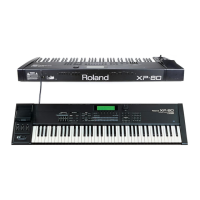96
❚
About the sequencer
A sequencer records keyboard performance and controller
movements as MIDI messages (sequencer data). As the data
plays back, the recorded MIDI messages are sent to a sound
source which will produce the required sounds. The
sequencer actually plays instruments instead of the musi-
cian, and since it can record a musical performance, it is a
tape recorder as well. But in reality a sequencer doesn’t
record sound, but actually the steps that cause the sound
source to produce sound, so it offers several advantages.
Sound quality is always excellent, the equivalent of first-gen-
eration tape, no matter how many times the data plays back;
tempo changes have no effect on pitch; detailed editing is
possible, etc.
Songs
For the XP-80, musical performance data for one song or
composition is referred to as a ‘song.’ A song combines
sequencer data recorded on Phrase tracks 1–16, a Tempo
track, a Beat track and a Pattern track, as discussed below.
Track configuration
Each section of a song which stores musical performance
data is called a ‘track.’
Phrase tracks 1–16
Phrase tracks record the musical performance of an instru-
ment. There are 16 Phrase tracks, and each track records data
of 16 MIDI channels. Totally, up to 16 tracks✕16 MIDI chan-
nels of data can be recorded.
Tempo track
The Tempo track records tempo changes of a song over time.
It can be used for tempo changes during a song. If a song has
the same tempo from beginning to end, the Tempo track can
be ignored.
When a song is first recorded on the XP-80, a tempo setting
at the time of recording will be stored at the beginning of the
Tempo track. Therefore when song playback starts from the
beginning, the song will always play back at this initial
tempo.
Thus playback tempo is determined by the Tempo track set-
ting. If you modify the tempo during playback, the overall
tempo of the song will be controlled by the setting you
make.
Beat track
The Beat track records the time signature of each measure of
a song. Set the Beat track when recording a new song, or
when you want to change time signature during a song.
Pattern track
You can also use the Pattern track to record musical pas-
sages, separately from the Phrase tracks. Musical data in the
Pattern track is regarded as separate Patterns. Up to 100
Patterns can be created, and each Pattern can contain data
for 16 MIDI channels, as with Phrase tracks.
Pattern Call massages (messages commanding specified
Patterns to play back) can also be recorded on a Phrase track
and a song created by combining several Patterns.
Positions for storing a song
Internal memory
The sequencer has an area called ‘internal memory’ that can
temporarily store one song. So we call this temporary song
‘Internal Song’.
To play back a song saved to a disk with the XP-80, it
doesn’t have to be loaded into internal memory. Only when
you’re going to record a song or edit a song saved to disk,
do you have to load it into internal memory. Since only one
song can be worked on during recording or editing, all the
internal memory has to do is store one song (about 60,000
notes).
The song in internal memory is volatile and will be lost
when the power is turned off. To keep a song, you must save
it to disk.
Disk
When keeping a recorded or edited song in internal memo-
ry, save it to disk as a song file. Up to 99 songs can be saved
to a single disk.
A disk can contain five file types. The three-letter symbol
shown in parentheses ( ) is a file name extension that distin-
guishes the different file types.
Song file (.SVQ)
This file is a song created on the XP-80. It is called an ‘MRC
Pro song.’ Other MRC Pro songs include those created on
the XP-50.

